|
"As my own individual research themes for long time, we have been studying effects of seismic isolation and vibration control of buildings, as well as indoor damage evaluation such as what kind of furniture falls in what kind of vibration (during earthquakes), or how much it moves." Dr. Mika Kaneko, General Manager of the Center for Safety and Reliability Engineering, Institute of Technology, SHIMIZU CORPORATION was assigned to Osaki Laboratory (at that time) when she joined the Company about 30 years ago, which had started in 1982 along with inauguration of Prof. Yorihiko Osaki, former Professor Emeritus of Tokyo University, as Vice President of the Company. There she was engaged in research using diverse simulation analyses concerning earthquakes for nearly 20 years. Since then, she has been devoting herself entirely to the research field. She looked back that what she considered especially unique about these efforts was focus not only on "whether a building itself collapses or not" in the earthquake but also on the fact that "even though a building does not collapse, its vibration causes very dangerous conditions, e.g. with furniture falling down inside". |
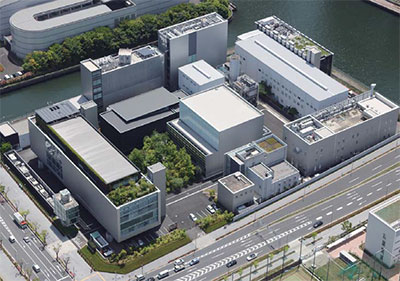 |
|
|
Researches from such points of view were still kept on after she moved to the Institute of Technology. 4 and half a year ago when the Center for Safety and Reliability Engineering was established in the Institute, however, she took a position as General Manager of the Center. Since then, she has been engaged exclusively in management of research and development in the Center she belongs to. |
||
Our user to feature in this issue is SHIMIZU CORPORATION, one of the socalled
super (major) general contractors that boasts of its history of more than
200 years for construction of buildings and civil engineering structures
with its abundant achievements. We put special focus on "Center for
Safety and Reliability Engineering", one of 6 Centers composing "Institute
of Technology" that takes charge of research and development and verification
of development technologies etc. towards realizing structures with high
added values.
Originally, the Company had introduced FORUM8 products since 1980's centering
on the design division. A year and a half ago, the Advanced Earthquake
Engineering Laboratory was established within the Institute of Technology.
At the same time, a large-stroke shaking table was built up and is operated.
It reproduces vibrations on the top floor of skyscrapers by reflecting
a variety of earthquakes using "UC-win/Road", FORUM8's threedimensional
(3D) real-time VR.
| Aiming at Development of New Technology Required Based on a Hard Look at What Things Will Be Like in 10 Years |
|
SHIMIZU CORPORATION was founded in 1804, 212 years ago when the founder Kisuke Shimizu opened a business at the Kanda Kaji cho district of Edo. Later, after constructing the West Wing of the Edo Castle, expanding into Yokohama along with the opening of the port (1859), and learning construction technology of western architecture there, it constructed a large number of buildings and infrastructures that colored Japanese modern history in and after the Meiji era. Through repeated expansion and restructuring of the organization, it still puts an emphasis on diligent study of technologies to lead the needs of the times in a wide range of areas of architectural and civil engineering construction as well as provision of their outcomes. In this process, Research and Development Section, predecessor of the Institute of Technology, was established in the design department of the Company in 1944. In 1972, the present Institute of Technology was constructed in Koto-ku, Tokyo. In 2003, the new main building of Institute of Technology was completed for the 200th anniversary of foundation. Under the keyword "Prepare for the 10 years to come" (Mr. Hiroshi Ishikawa, Director of Institute of Technology), the Institute takes an approach of actively developing new technologies that will be required in the future in anticipation of the times, says Dr. Kaneko, General Manager of the Center. The implementing entities of the Institute of Technology are currently the following 6 centers. |
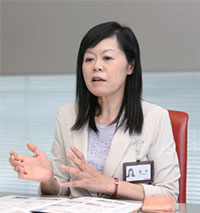 |
|
Center for Safety and Reliability Engineering, Institute of Technology, SHIMIZU CORPORATION |
- "Center for Construction Engineering" for technologies that forms the basis in constructing buildings and civil engineering structures, including materials, structural frames, soils and foundations, facilities, and fire safety.
- "Center for Environmental Engineering" for environmental technologies that are directly related with life, including wind and heat, acoustics, nature, and healthcare.
- "Center for Safety and Reliability Engineering" that pursues efforts to deliver safety and security to society through technologies to forecast, evaluate, and minimize risks in the event of diverse natural disasters such as earthquakes and accompanying tidal waves (tsunamis) or abnormal weather.
- "Center for Energy Engineering" for technological challenges concerning energy conservation in buildings and town blocks, adoption of renewable energy, and atomic energy etc. while targeting a sustainable low-carbon society.
- "Center for Social System Engineering" for software and hardware technologies concerning new infrastructure construction that meets the needs of societies, methods for preservation and renewal in consideration of existing infrastructures and local values.
- "Center for Future Technology and Design" that seeks to create inspirational spaces and environments as well as new value using advanced technologies freely.
Their operations are supported by R&D Planning Department and R&D Administration Center. Among 10,750 employees of the Company in total, 234 members including 181 researchers belong to the Institute of Technology. The Center for Safety and Reliability Engineering has 35 staff members including researchers (as of April 2016).
| Positive Use of Advanced ICT for Earthquake Countermeasures etc. |
"Though 'Safety and reliability' covers a wide range of areas, it is earthquake countermeasures that we are putting the greatest emphasis (in our activities) on".
Dr. Kaneko, General Manager of the Center says that as stated before, the Center for Safety and Reliability attaches great importance not only to earthquake countermeasures but also to research and development with focus on the risks caused by tsunami or abnormal weather such as torrential rainfall and tornados in recent years.
Based on this, she classifies the approaches to these problems in the Center into three types as follows:- Evaluation technologies before disasters occur (software)
- Countermeasure technologies for particular targets such as earthquakes (hardware)
- Preparation for the cases when disasters actually occur (skill)
- In terms of software, a system for proposing the optimum solution by predicting and diagnosing vibrations of earthquakes and tsunami motions, and their effects on buildings and facilities ("Shimizu's comprehensive disasterprevention diagnostics system" and "Tsunami Simulation System" etc.)
- In terms of hardware, technologies and equipment for strengthening structures directly (rotating inertial mass damper, partial base isolation system, low-cost liquefaction countermeasure construction method, and seismicresisting technology for ceilings)
- In terms of skills, systems for supporting the clients' safety and reliability after the occurrence of earthquakes (a system for automatic judgment of soundness of buildings right after the occurrence of an earthquake with pre-installed sensors, and a system for allowing elevators to stop at the nearest floor in conjunction with Earthquake Early Warnings).
The Company’s positive response to ICT (Information and communications technology) also reflects on the basis of such development. For example, in the system for automatically judging the soundness of buildings, a system of IoT (Internet of Things), which attracts attention in recent years, has been installed early ahead of others to install a large number of sensors in the building beforehand.
| Large-stroke Shaking Table Using UC-win/Road Installed in Advanced Earthquake Engineering Laboratory |
"Since the old shaking table we used to have was made nearly 30 years ago with motion (stroke) of ±20 cm, there was a limitation in reproducing the vibrations (of the top floor of a skyscraper that may move more than 1 meter). So we started to think of creating a new shaking table before the occurrence of the Great East Japan Earthquake (2011)".
It was encouraged to give shape to this idea when the Earthquake caused large vibrations of super high-rise buildings in the city center of Tokyo, which suddenly attracted attention, says Dr. Kaneko, General Manager of the Center.
With this as the background, the Advanced Earthquake Engineering Laboratory opened on the premises of the Institute of Technology in March 2015. It was expected to serve as the basis for realizing "BCP (Business Continuity Plan) of a rank up" by contributing not only to technological development in terms of software and hardware but also to improvement in skills.
The facility as the centerpiece of the laboratory is a large-scale shaking table "E-Beetle" and a large-stroke shaking table "E-Spider".
E-Beetle mounts the acceleration performance (Acceleration when loading 35 t: 2.7 G, stroke: ±80 cm) capable of reproducing vibrations of all kinds of earthquakes in the world. Measuring 7 m square, the table (maximum weight bearing capacity: 70 t) allows testing for constructing structures with higher earthquake-resistance by loading a model of the building or a part cut from the fullscale building on it to grasp the behavior of the building up to its collapse and its seismic resistance performance.
On the other hand, E-Spider's maximum acceleration is 1 G (with 3 t load) and amplitude is ±1.5 m. As it can be tilted diagonally in addition to upwards and downwards motions, it allows reproduction of the vibration peculiar to the top floor of a high-rise building. It makes it possible to understand the behavior of furniture inside the rooms of the building. Besides experiments of vibration, for the purpose of getting people to feel bodily sensations of an earthquake by actually placing them on the table, a cabin (a rectangle box) is mounted on the table measuring 4 m x 4 m. The experiencing cabin is equipped with a large-scale screen on the front, faced by the seats (for 4 people) and standing spaces (for 5 people). Enabled by UC-win/Road, it also incorporates a system for viewing the video images and hearing the sound of falling furniture etc. within the room according to the physics model in synchronism with the shaking.
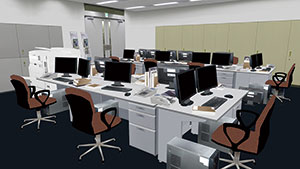 |
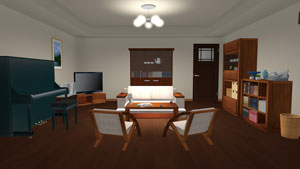 |
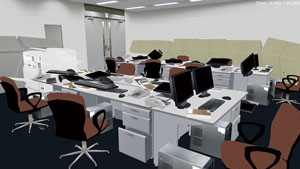 |
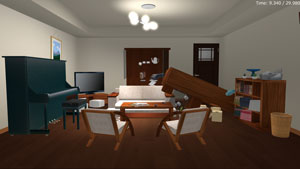 |
to simulate their effects on the fi xtures and furniture inside the building. |
|
| Utilization of E-Spider and Its New Possibilities |
In response to the specific request that they "want to create a shaking table that gives visitors a vivid sense of earthquake motions by actually getting on it, and see the video image (of inside of the room as it changes) along with the shaking, the Company and FORUM8 held the first meeting in April 2012. Later, the mechanism of synchronizing the images and sound of VR with the shake on the side of the motion was built up while controlling the wave pattern of the earthquake and calculating on a realtime basis between E-Spider and UC-win/ Road. It is also possible to reproduce the difference in vibration between a baseisolated building and a building without base isolation, as well as the vibration of long-period earthquake motion.
Since the operation started in the Advanced Earthquake Engineering Laboratory, experiences of earthquakes with E-Spider have been made open to public for the clients of the Company centering on the owners of buildings and production facilities. It was so thriving as to involve a waiting list, with 2,600 visitors in the last fiscal year (from April 2015 to March 2016). Not a few people voiced their astonishment at its realistic shaking and images, according to her.
It is also possible for Dr. Kaneko, General Manager of the Center to reproduce the vibration of the concerned earthquake easily using the earthquake wave pattern data made public by herself. Therefore, she pays attention to the advantage that the in-house researchers can reflect the experiences on their researches. She considers that it helps the research and development to increase in speed.
Additionally, based on the data designed by the designer, it is possible to have bodily experiences in advance as to how the building shakes, what kind of effects are brought about on the building or inside the room by different types of earthquakes that occur after the completion of the building, while the building is still in the design stage. It is expected to add persuasiveness to the explanation for their clients.
Moreover, it is also possible to apply E-Spider to research on the psychological and physiological effects of seismic motions. Some papers have already been issued on researches such as "Quantification of Human Senses to Shake".
She is willing to use it effectively both in dealing with clients and research & development.
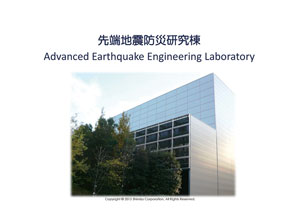 |
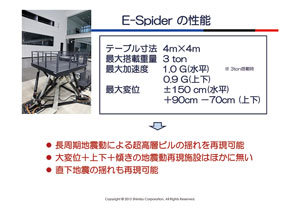 |
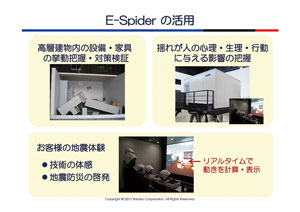 |
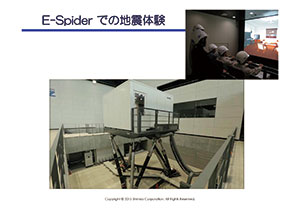 |
(Up&Coming 2016 Fall Issue)

